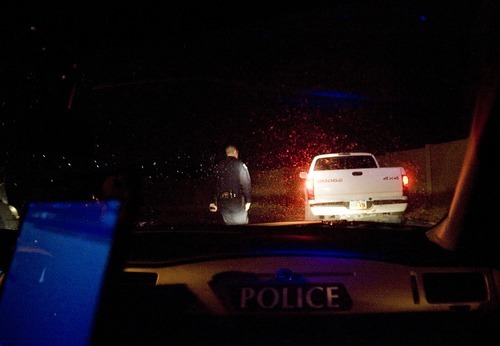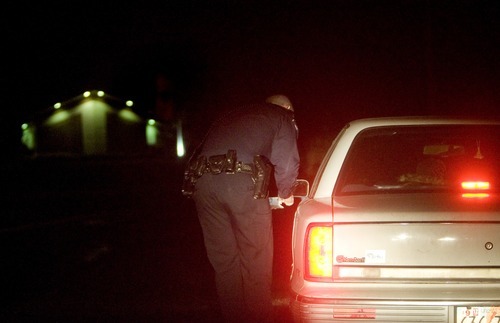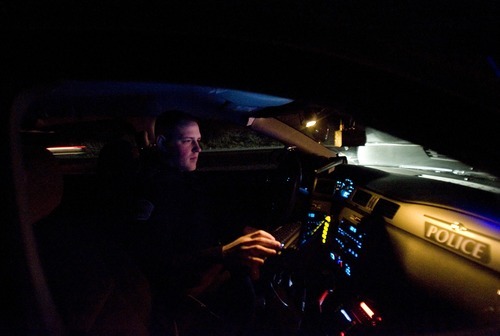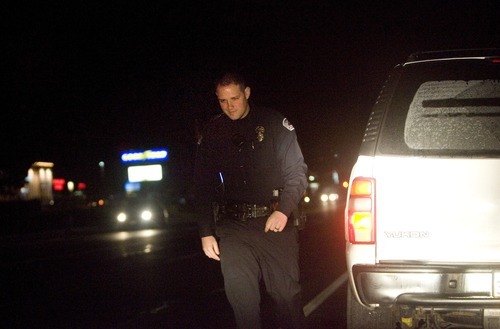This is an archived article that was published on sltrib.com in 2011, and information in the article may be outdated. It is provided only for personal research purposes and may not be reprinted.
To combat drunken driving and other alcohol-related problems, Riverton bought an inflatable arch.
The Utah County Sheriff's Office bought a dog. Delta helped pay for crossing guards.
All the expenditures were paid for, at least in part, with money from Utah's beer tax.
According to state law, in effect since 1983, the cities' and counties' share of the money that comes from every pint or six-pack must be spent on special projects preventing, enforcing or prosecuting alcohol offenses.
But a review by The Salt Lake Tribune has found that perhaps hundreds of thousands of dollars of beer tax money have been diverted to other causes or rolled into everyday city or county activities.
In some cases, the recipients seemingly stretched the interpretation of the statute to justify how they spent the money. Other municipalities didn't even try to explain how their purchases comply with the law.
The state agency which tracks the beer tax has found problems, too. The expenditures by 26 cities and counties are under review, said Mary Lou Emerson, director of the Utah Substance Abuse Advisory Council.
If it's determined any of those 26 misspent the money, a portion or all of what they would have received from the beer tax in fiscal 2012 will be withheld, Emerson said.
"They'll forfeit their money if it was a blatant misuse of funds," Emerson said.
Emerson declined to provide a list of the 26 cities or counties because her staff has not contacted all of them, but Emerson confirmed Salt Lake City and Salt Lake County are both on the list.
Public defenders • Salt Lake County spent $14,394 of the beer tax money providing defense attorneys and other legal assistance to the indigent. Salt Lake City spent $13,321 on indigent defense.
While the statue governing the beer tax allows for money to be spent prosecuting alcohol offenses, and defendants have a constitutional right to an attorney, Emerson said that doesn't mean cities and counties can spend the beer tax on public defense lawyers.
"That's not prosecution in my mind," Emerson said.
Riverton is another city that has caught the eye of the state, Emerson confirmed. That city received $31,820 in fiscal year 2011.
Riverton's report to the state says some of that money went to events like fishing tournaments, kickball games and Easter egg hunts geared toward steering teenagers away from drugs and alcohol, but the city also spent a portion of its money on suicide prevention at Riverton High School and family movie nights in a park.
Riverton said it also spent $14,476 of the beer tax funds to buy equipment, including the inflatable arch spanning the width of a suburban street, a trailer and a portable generator.
The portion of beer tax reserved for cities and counties is formally called the Alcoholic Beverage Enforcement and Treatment Restricted Account. Cities and counties received almost $5.6 million from the account during fiscal year 2011. The Substance Abuse Advisory Council divvies the money based on a formula that considers each city or county's population, the number of alcohol-related convictions there and the number of liquor licenses they have.
Beer tax payouts in fiscal year 2011 ranged from $8.57 for the hamlet of Ophir to $761,052 for Salt Lake County. Funds for the current fiscal year are suppose to be issued in the next few days, Emerson said.
The state law governing the fund says the money is "exclusively" for funding projects that reduce the overconsumption of alcohol by adults and minors. The statute goes on to say the fund is "intended to supplement the budget" of cities and counties and is "not intended to replace money that would otherwise be allocated for the programs and projects" that deter overconsumption.
Disclosure • Any city or county receiving at least $1,000 must file a report with the state accounting for the money. Emerson said when new staff joined the Substance Abuse Advisory Council this year they began reviewing how cities and counties were spending the beer tax. About the same time, Emerson said, she heard from someone "in a small community up north" who was concerned about how the beer tax was being spent there.
Emerson said she's not aware of any city or county ever losing its share or facing other sanctions for misappropriating the funds. The only time the council has withheld money is when a city or county failed to file a report explaining how the money was used.
"For the most part, I think it's being spent appropriately," Emerson said.
Yet Emerson pointed to some expenditures that don't seem to address the overconsumption of alcohol. The Utah County Sheriff's Office and Lone Peak Public Safety both spent portions of their beer tax on dogs. The reports didn't specify if the K9s specialize in finding drugs or people.
St. George directed its funds to county-wide drug and gang task forces.
Some cities and counties provided detailed reports explaining how they are following the statute. The Cache County Sheriff's Office provided a breakdown of the hours it spent in each of the towns it polices conducting drunken-driving checkpoints and patrolling for other alcohol violations.
Layton spent its $70,661 to pay for a police officer who works nights specifically to patrol for drunken drivers. The officer, Nick Nalder, says he averages one DUI arrest per shift, usually as the bars in Layton and Davis County are closing.
"It's mainly all proactive police work," Nalder said.
Yet some municipalities admit they are doing nothing special with the money.
"We do not have specific City sponsored programs or projects other than the routine patrolling of our City by the Sheriff's Office," the Weber County town of Plain City said in its report. Plain City received $3,507 in fiscal 2011.
Emerson said she's also worried the beer tax is being spent on what she calls "generic law enforcement materials." She pointed to how some police and sheriff's departments reported spending their money on items like dashboard cameras or fingerprinting equipment.
The Willard police chief said his department spent all $2,186 of its money toward the purchase of a license plate reader. The reader automatically compares license plate numbers to a national database for outstanding warrants.
"Our position is that the more vehicles that are stopped the higher likelihood that alcohol violations will be discovered," Chief Nate Thompson wrote.
Inflatable arch • Sometimes it's not clear how the beer tax was spent. In its report, Grand County labeled all $30,910 of its money as "Jail Expense" with no further description.
In Riverton, parks and recreation director Sheril Garn said the city used a portion of its beer tax to support a suicide prevention program because alcohol and drug use contribute to many suicides. As for the inflatable arch, it's been used at events designed to keep teenagers away from drugs and alcohol, as well as for larger community events like 5K runs and half-marathons.
"It's just a fun thing to have for all the events and bring a festive feel," Garn said.
Greg Schafer, the recorder and director of finance in Delta, said that town placed its $6,803 of beer tax money into its line item for public safety. That means the money helped pay Delta's contract for policing services from the Millard County Sheriff's Office and other items such as crossing guards. Schafer said about $500 of the money pays to send a mental health professional to a University of Utah workshop on substance abuse treatment and prevention.
Schafer and Garn said the Substance Abuse Advisory Council has never given their cities instruction on how the money is to be used or offered a critique.
Emerson said she's not aware of the council ever offering training on how the money is to be spent. The standard form the cities and counties can use to report their spending directs the respondent to what used to be the state statute governing the fund. However, in 2010 the Legislature moved the law to a different chapter of state code, and the Substance Abuse Advisory Council did not update the form.
As for the state review, Emerson doesn't believe cities and counties are knowingly misusing the money.
"We will just advise them this is a use not authorized by the statute and we will withhold all or a portion of their funds," Emerson said.
ncarlisle@sltrib.com
Twitter: @natecarlisle —
Beer Tax impact
How successful the fund has been in decreasing alcohol overconsumption is unclear. Arrests for driving under the influence have increased since 2007, while arrests for drunkenness and violations of the state's liquor laws have declined in that time, according to the Utah Department of Public Safety.
A 2010 report from the Utah Department of Human Services found alcohol use among youth in Utah was decreasing, but binge drinking and heavy alcohol consumption by adults was stable.













